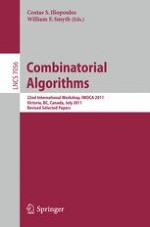This book constitutes the thoroughly referred post-workshop proceedings of the 22nd International Workshop on Combinatorial Algorithms, IWOCA 2011, held in Victoria, BC, Canada, in July 2011. The 30 revised full papers presented were carefully reviewed and selected from a total of 71 submissions. A broad variety of topics in combinatorics and graph theory are addressed, such as combinatorics on words, string algorithms, codes, Venn diagrams, set partitions; Hamiltonian & Eulerian properties, graph drawing, colouring, dominating sets, spanning trees, and others.
